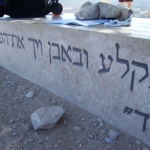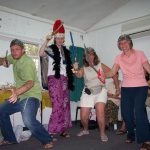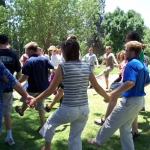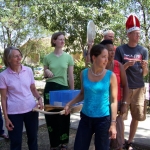Immersion Course Methodology and Description
Biblical Language Center’s (BLC) courses and products are unique in biblical language learning.
 Since 1996, BLC has offered innovative instruction for Biblical Hebrew and Koine Greek using cutting-edge methods for language acquisition. We continually refine our techniques and materials to insure the most efficient achievement of the biblical languages anywhere in the world.
Since 1996, BLC has offered innovative instruction for Biblical Hebrew and Koine Greek using cutting-edge methods for language acquisition. We continually refine our techniques and materials to insure the most efficient achievement of the biblical languages anywhere in the world.
We have found that a successful language learner already starts to think in and to understand a language before literacy. An effective audio and oral internalization of a language is necessary to enhance reading comprehension and speed, and to boost long-term retention. One cannot fluently read the Bible in its original languages, without those very languages living inside of them.
BLC’s goal is for students to fluidly read the Bible with a natural and instant comprehension. Therefore, BLC immersion courses use living language methods in teaching Biblical Hebrew and Koine Greek. This means that more than 90% of classroom time is filled with the spoken biblical language. The result is an internalization of the languages which speeds the pace of learning and improves the reading of the biblical text.
Our courses provide for continual usage and varied repetition of the biblical languages within meaningful and comprehensible contexts. This means that students will assimilate the languages with a creative and thorough assortment of interaction. (Within the professional field of second language acquisition, this kind of class is called communicative la nguage learning and provides maximal comprehensible input, techniques that are at the core of the most successful modern language programs in the world.)
nguage learning and provides maximal comprehensible input, techniques that are at the core of the most successful modern language programs in the world.)
To begin, every BLC course is led by two instructors. The student benefits in numerous ways by having dual teachers. First, it allows the student to hear the language through different voices, giving a more comprehensive ear to proper enunciation. Second, two teachers can encourage language repetition as one instructor can often mimic or respond to the other, whether in word or deed. This in-classroom interaction between teachers demonstrates language usage for the students just as communication between two parents would model language for their children. Third, teachers can also use each other as pedagogical props when introducing new vocabulary and grammatical context. Fourth, by having two instructors, both teachers’ efficiency increases, with a real-time peer review from the other instructor. While one teacher is leading, the other teacher can be observing the students interaction (or lack of interaction) and then adapt the current class curriculum accordingly to better suit students’ needs.
One teaching technique used in the BLC classroom experience is Total Physical Response (TPR) where students respond to commands that require physical movement. (For a review of this method, see Stephen Krashen.)This practice is based  on the parent-child model where a language learner hears and imitates the leader by physically responding to the language. Just as a child follows a parent’s example and begins to internalize the language, so does the BLC student. After an initial week of hearing and absorbing the language in class, plus acquiring the alphabet through picture association homework, the student then begins reading and using words and phrases related to the classroom activities.
on the parent-child model where a language learner hears and imitates the leader by physically responding to the language. Just as a child follows a parent’s example and begins to internalize the language, so does the BLC student. After an initial week of hearing and absorbing the language in class, plus acquiring the alphabet through picture association homework, the student then begins reading and using words and phrases related to the classroom activities.
TPRS (Teaching Proficiency through Reading and Storytelling) is another method used with students as they advance further and interact with the language. TPRS builds language proficiency in the use of grammatical structures through reading and telling stories. BLC teachers guide the class in creating unique stories based on students’ input. By developing these stories completely within an immersed language environment, students further their understanding and thinking within the biblical language. At this point, students might begin to produce pieces of the language spontaneously.
For homework, students continue to immerse themselves in the language through BLC’s audio-lingual materials. These books and related audio tracks review class work from that day and prepare students for the coming class. Depending on the specific course, the audio tracks will correspond either to picture immersion, dialogues for memory work, texts and narratives for familiarization, and/or drills to practice in  workbooks. The priority homework assignment, though, is mentioned in the next paragraph.
workbooks. The priority homework assignment, though, is mentioned in the next paragraph.
Maybe most importantly, relaxation and fun are proven course components that aid language learning. BLC’s courses are designed to ease classroom stress and to encourage student morale. This is generated by activities which focus on the excitement and creativity of classroom play. One of the best ways to learn is when a student forgets they are “in class”, but are enveloped by the exhilaration of the moment. Our classroom environment inspires students to play in, use, and ultimately immerse themselves within the language. Of course, just like someone going to a summer sports’ camp, this fun will be tiring. BLC courses demand eight hours of sleep as “homework assignment #1”. If a conflict ever occurs, eight hours of sleep takes precedence over other assignments because it enables a student to absorb more of the language on the following day.
Occasional class field trips within Israel will also touch on cultural, geographical and historical information connected to the biblical text. Here, texts are read in their related settings while descriptions to the sites are provided in simple forms of the language.
Students desiring academic credit will write a final exam and be issued a six-credit certificate for the four-week beginning immersion courses (90 academic hours, 6 Continuing Education Units) or a three-credit certificate for the two-week immersion courses (45 academic hours, 3 Continuing Education Units). Transfer of credit depends on the student’s home institution.

